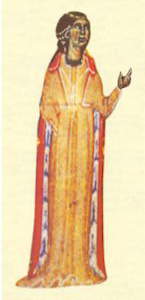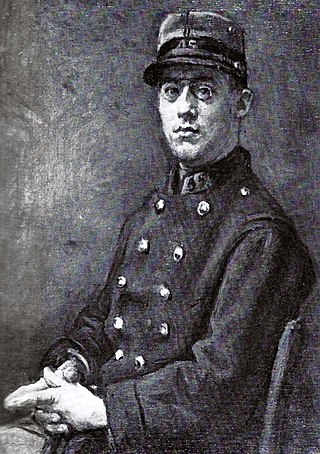
A troubadour was a composer and performer of Old Occitan lyric poetry during the High Middle Ages (1100–1350). Since the word troubadour is etymologically masculine, a female equivalent is usually called a trobairitz.

Courtly love was a medieval European literary conception of love that emphasized nobility and chivalry. Medieval literature is filled with examples of knights setting out on adventures and performing various deeds or services for ladies because of their "courtly love". This kind of love was originally a literary fiction created for the entertainment of the nobility, but as time passed, these ideas about love spread to popular culture and attracted a larger literate audience. In the high Middle Ages, a "game of love" developed around these ideas as a set of social practices. "Loving nobly" was considered to be an enriching and improving practice.

A nocturne is a musical composition that is inspired by, or evocative of, the night.
A song cycle is a group, or cycle, of individually complete songs designed to be performed in sequence, as a unit.

Alexis-Emmanuel Chabrier was a French Romantic composer and pianist. His bourgeois family did not approve of a musical career for him, and he studied law in Paris and then worked as a civil servant until the age of thirty-nine while immersing himself in the modernist artistic life of the French capital and composing in his spare time. From 1880 until his final illness he was a full-time composer.

The Tagelied is a particular form of mediaeval German-language lyric, taken and adapted from the Provençal troubadour tradition by the German Minnesinger. Often in three verses, it depicts the separation of two lovers at the break of day.

The trobairitz were Occitan female troubadours of the 12th and 13th centuries, active from around 1170 to approximately 1260. Trobairitz is both singular and plural.
French folklore encompasses the fables, folklore, fairy tales and legends of the French people.

Alexandre Tharaud is a French pianist. He is active on the concert stage and has released a large and diverse discography.

The Avant-dernières pensées is a 1915 piano composition by Erik Satie. The last of his humoristic piano suites of the 1910s, it was premiered by the composer at the Galerie Thomas in Paris on May 30, 1916, and published that same year. A typical performance lasts 3–4 minutes.
Histoires naturelles is a song cycle by Maurice Ravel, composed in 1906. It sets five poems by Jules Renard to music for voice and piano. Ravel's pupil Manuel Rosenthal created a version for voice and orchestra. The cycle is dedicated to the mezzo-soprano Jane Bathori, who gave the first performance, accompanied by the composer, on 12 January 1907.

The Pièces froides are two sets of piano pieces composed in March 1897 by Erik Satie. Unpublished until 1912, they marked Satie's break from the mystical-religious music of his "Rosicrucian" period (1891–95), and were a harbinger of his humoristic piano suites of the 1910s.

The Sarabandes are three dances for solo piano composed in 1887 by Erik Satie. Along with the famous Gymnopédies (1888) they are regarded as his first important works, and the ones upon which his reputation as a harmonic innovator and precursor of modern French music, beginning with Debussy, principally rests. The Sarabandes also played a key role in Satie's belated "discovery" by his country's musical establishment in the 1910s, setting the stage for his international notoriety.

The Trois poèmes d'amour is a 1914 song cycle for voice and piano by Erik Satie. It is the only set of mélodies Satie composed to his own texts. In performance the set lasts between 2 and 3 minutes.

Alborada del gracioso is the fourth of the five movements of Maurice Ravel's piano suite Miroirs, written in 1905. It is about seven minutes long and, as part of the suite, has always been regularly played and recorded by pianists. Alborada was orchestrated by Ravel fourteen years later for use as a ballet. In this form, as a standalone orchestral piece, it is often played in concert.

The Quatre petites mélodies is a 1920 song cycle for voice and piano by French composer Erik Satie. It is most notable for its opening lament, Élégie, which Satie composed in memory of his friend Claude Debussy. A typical performance lasts under 4 minutes.

Trois mélodies is a 1916 song cycle for voice and piano by Erik Satie. One of Satie's rare excursions in mélodies, it lasts under four minutes in performance.

The French composer Emmanuel Chabrier (1841–1894) wrote music in many genres, including opera and operetta, piano, orchestral music, and songs with piano accompaniment. The songs cover most of his creative years, from the early 1860s to 1890, when the illness which would kill him prevented much composition. He came late to music as a profession, but – although being an exceptional pianist – he had no trappings of a formal training: no conservatoire studies, no Prix de Rome, "none of the conventional badges of French academic musicians, by whom he was regarded as an amateur".
The serena is a minor Old Occitan lyric genre. Despite the name, it is not a serenade. Rather, it is a counterpart to the alba. In an alba, the lover laments the coming of the dawn that forces lovers to part. In the serena, the lover complains of the long wait for evening to arrive so he can consummate his love. The genre was invented late in the history of the Occitan lyric by the troubadour Guiraut Riquier in his song Ad un fin aman fon datz, which he claimed to have completed in the year 1263, when he was living in Narbonne. The refrain of Guiraut's serena goes:












